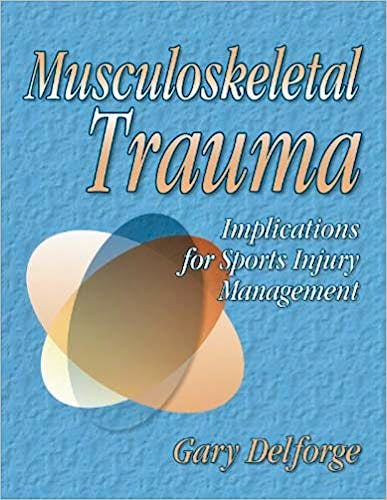

No hay productos en el carrito



Musculoskeletal Trauma - Implications for Sport Injury Management
Delforge, G.
1ª Edición Mayo 2002
Inglés
250 pags
1000 gr
22 x 29 x 2 cm
ISBN 9780736038799
Editorial HUMAN KINETICS BOOKS
Description
When sports injuries occur, health care clinicians face a difficult challenge: to get athletes back to activity safely and quickly with minimal risk of reinjury.
Musculoskeletal Trauma: Implications for Sports Injury Management will provide you with a conceptual framework for clinical decision making in the therapeutic management of sport-related soft tissue injuries, fractures, and proprioceptive/sensorimotor impairments. This well-organized book identifies major categories of therapeutic intervention that parallel the sequential events of tissue healing after musculoskeletal injury. It provides you with sound rationale for development of progressive therapeutic strategies.
Author Gary Delforge organized this book according to three main categories of sport injuries to enhance your understanding of relevant anatomy and physiology, specific tissue healing mechanisms, and associated implications for therapeutic intervention.
This easy-to-follow book begins with an introduction to clinical decision making and a review of basic concepts in sports injury management, provides detailed content on the pathology and treatment implications of the three major sports injury types, and concludes with a presentation of conceptual guidelines for sports injury assessment and rehabilitation.
Special features include the following:
- Detailed description of the primary biological responses to sport-related trauma throughout the tissue healing process
- Problem-solving scenarios and questions that challenge your application of information to clinical practices
- An at-a-glance appendix with definitions of key terms
- More than 50 detailed medical illustrations
Using a problem-solving approach to the treatment of sports injuries, this book will help you develop effective therapeutic strategies—from initial injury management through rehabilitation and return to activity. It will enhance your ability to plan comprehensive rehabilitation programs and select therapeutic techniques based on knowledge of typical tissue responses to musculoskeletal trauma.
Contents
Part I: Foundations of Sports Injury Management
- Chapter 1. Introduction to Sports Injury Management
- The Problem-Oriented Approach
- Basic Concepts in Sports Injury Management
- Normal Tissue Structure and Function
- Essential Elements in Tissue Healing
- Summary
- References
- Chapter 2. Hemorrhage and Hemostasis
- Primary Hemostasis
- Secondary Hemostasis
- Hemorrhagic Manifestations
- Summary
- References
Part II: Soft Tissue Repair and Therapeutic Intervention
- Chapter 3. Soft Connective Tissue Repair
- Inflammation
- Fibroplasia
- Scar Maturation
- Tissue Repair Complications
- Summary
- References
- Chapter 4. Therapeutic Implications: Inflammation and Pain
- Management of Hemorrhage and Edema
- Alleviation of Pain and Muscle Spasm
- Summary
- References
- Chapter 5. Therapeutic Implications: Scar Formation and Maturation
- Enhancement of Connective Tissue Repair
- Prevention of Contractures and Adhesions
- Enhancement of Scar Tissue Structure and Function
- Summary
- References
Part III: Fracture Healing and Therapeutic Management
- Chapter 6. Fracture Healing
- Morphology and Histology of Bone
- Bone Regeneration and Repair
- Abnormal Bone Healing
- Summary
- References
- Chapter 7. Therapeutic Implications: Fracture Healing
- Basic Concepts in Fracture Management
- Principles of Fracture Treatment
- Preservation and Restoration of Function
- Resumption of Sports Participation
- Summary
- References
Part IV: Proprioceptive and Sensorimotor Deficits and Therapeutic Intervention
- Chapter 8. Proprioception and Sensorimotor Function
- The Peripheral Proprioceptive System
- The Vestibular System
- The Visual System
- Summary
- References
- Chapter 9. Therapeutic Implications: Proprioceptive and Sensorimotor
- Deficits
- Pathology of Proprioceptive Deficits
- Therapeutic Implications
- Summary
- References
Part V: Problem Solving in Sports Injury Management
- Chapter 10. Sports Injury Assessment and Problem Identification
- The Problem-Oriented Medical Record
- Summary
- References
- Chapter 11. Sports Injury Treatment and Rehabilitation Planning
- Rehabilitation Goals and Objectives
- Principles and Concepts in Rehabilitation Planning
- Summary
- References
- Appendix
- Index
Author
Gary Delforge, EdD, ATC, draws from more than 40 years of experience as a certified athletic trainer and educator. Most recently, he served as director of the sports health care department at the Arizona School of Health Sciences, a division of Kirksville College of Osteopathic Medicine, where he developed an NATA-accredited master's degree program in athletic training. For 32 years he was associated with the University of Arizona, where he served for 7 years as head athletic trainer before devoting his time to curriculum development and teaching in athletic training.
As an active member of the NATA for many years, Dr. Delforge chaired the NATA Professional Education Committee and served as a member of the NATA board of directors. He is also a recipient of the Sayers “Bud” Miller Distinguished Athletic Training Educator award and a member of the NATA Hall of Fame.
He has written many journal articles and book chapters and presented frequently at national and regional meetings. Dr. Delforge earned his EdD in rehabilitation administration at the University of Arizona and a master's degree in health, physical education, and recreation at Kent State University.
© 2025 Axón Librería S.L.
2.149.0